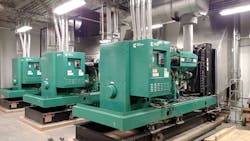Most of my previous articles have focused on big electrical “system” issues, complex design issues, or issues of controversy — but the topic for this article is a bit different. I want to focus on a single Code requirement — the shutdown requirements for a prime mover (aka, generator). The original intent of this article was to quickly highlight a change in the 2017 NEC, but being a Code nerd I started crosschecking other Sections in the Code to validate alignment of this new directive. Once I started doing this, the “simple” topic became significantly more complex.
Section 445.18 was revised in the 2017 National Electrical Code. In the 2014 version, this section was titled “Disconnecting Means Required for Generators.” It is now titled “Disconnecting Means and Shutdown of Prime Movers” and is split into Sections (A) “Disconnecting Means” and (B) “Shutdown of Prime Mover.” The general intent of this requirement is very similar to what it was in the 2014 edition with one significant exception. Section 445.18(B) now indicates: “Generators with greater than 15kW rating shall be provided with an additional requirement to shut down the prime mover. This additional shutdown means shall be located outside the equipment room or generator enclosure and shall also meet the requirements of Sec. 445.18(B)(1) and (B)(2).”
What this means is that both exterior and interior generators are required to have a second means of shutting down the prime mover. This second means is to be a remote shutdown (stop) that is not physically located on the prime mover, on the prime mover enclosure, or within the room that the prime mover is located.
I know what you are now saying to yourself. How is this in alignment with Sec. 700.12(B)(6), right? This Section indicates an additional “disconnecting means” is not required if the disconnecting means for the exterior generator is in accordance with Sec. 445.18, is readily accessible, and is within sight of the structure it serves. One could be misled to believe that the additional shutdown means is not required. If you read this Section 27 times, you will realize that 700.12(B)(6) references disconnecting means and not the means to shut down the prime mover. These are two separate objectives.
Article 5.6.5.6 in NFPA 110, “Standard for Emergency and Standby Power Systems” (2016 edition), requires that “All installations shall have a remote manual stop station of a type to prevent inadvertent or unintentional operation located outside the room housing the prime mover, where so installed, or elsewhere on the premises where the prime mover is located outside the building.” After reading this Article 43 times, I still think the wording is awkward. The Annex information for the Article states: “For systems located outdoors, the manual shutdown should be located external to the weatherproof enclosure and should be appropriately identified.” This helps clarify that the intent of the Article is that a manual shutdown is required for exterior generators and that the shutdown station cannot be located within the generator enclosure. What the Annex doesn’t quite clarify is the statement of “all installations shall have a remote manual stop station” portion. If the commas were relocated, this Article could be interpreted to actually be closely aligned with the changes in Sec. 445.18 of the 2017 NEC. The revisions to 445.18 now indicate that the remote manual stop cannot be located on the enclosure, so that verbiage is more stringent than NFPA 110.
So, after an exhausting analysis of NFPA 70 and NFPA 110, the summary of the “simple” Code change I was hoping to convey is: Both interior and exterior generators require a secondary remote stop, and that remote stop to shut down the prime mover and the remote stop station cannot be located within the same room as the prime mover or located on an exterior generator enclosure. (Note I did say exhausting — not exhaustive search. As with most Code items, once you start down the rabbit hole, there is always another Code reference that will suck you in and add to your analysis.)
About the Author
Krista McDonald Biason, P.E.
Associate Vice President
Krista McDonald Biason, P.E., is the national electrical practice leader at HGA Architects and Engineers in Minneapolis, where she specializes in electrical infrastructure planning and design for health care, commercial and community projects. She is a member of ASHE (American Society for Healthcare Engineering), and serves on the NFPA (National Fire Protection Association) 70 National Technical Committee-Code-Making Panel 13, which develops NEC (National Electrical Code) articles pertaining to emergency power systems.
